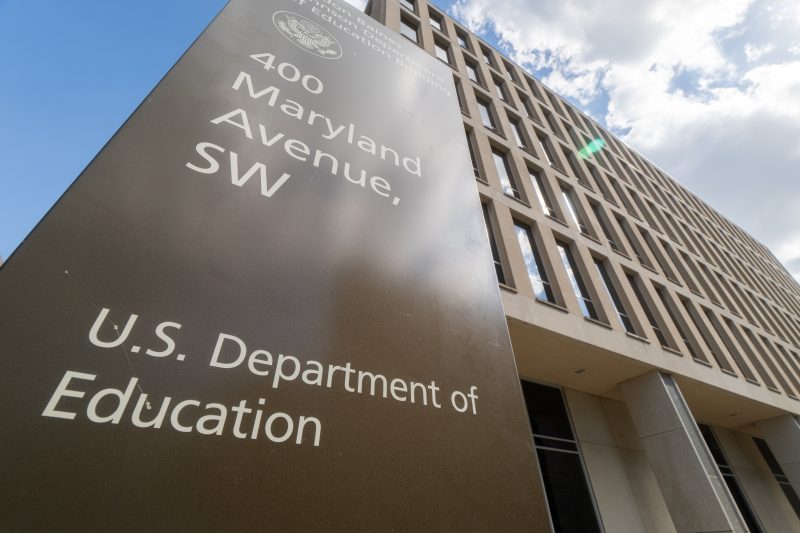(The Hill) — Black educators are sounding the alarm as President Donald Trump ramps up talk of eliminating the Department of Education.
Trump, who has long called for the Education Department to be shut down, said in the Oval Office on Tuesday that he hopes Linda McMahon, his nominee for Education Secretary, can “put herself out of a job.”
What happens if the Department of Education is abolished?
“We’re ranked very badly. And what I want to do is let the states run schools,” he said.
Reports that Trump is drafting an executive order to cripple the department began circulating a day earlier. According to The Wall Street Journal, the president is looking to begin with taking away programs not explicitly written into law and moving functions to different departments before calling on Congress to pass a law abolishing the federal agency completely.
But educators warn the loss of federal agency will exacerbate racial disparities in schools across the nation, including in universities and colleges.
“Since 2020, there have been some true coordination and attacks on public education as we know it, and I think our current administration is challenging what it means for us to provide a public education for all students,” Jalisa Evans, founder and CEO of the Black Educator Advocates Network (BEAN), told The Hill.
“For folks who’ve been committed to protecting public education for Black and Brown children, and really protecting Black students’ experiences, the job just got even harder,” Evans said.
The Department of Education, created in 1979, develops and enforces federal education laws, administers financial aid programs and conducts research on schools, students and educational issues.
“When the department was created, it was created to help monitor things like the fair distribution of resources and to help monitor civil rights,” said Patrick Rice, chair of the Black Educational Advocacy Coalition (BEAC).
Delaware governor on Trump’s threats: ‘Let’s govern with compassion’
But a multitude of studies show schools that primarily serve Black and other students of color still often lack resources.
A CBS report found that, from 2015 to 2020, districts made of at least 80 percent of Black students invested only about half as much money in buildings as those that had less than 20 percent of Black students enrolled. The disparities were in part because districts that are at least 80 percent Black received only about a quarter of the money compared to those with fewer Black students.
That funding is one of advocates’ top concerns.
Patrice Willoughby, senior vice president of global policy and impact at the NAACP, said she is most worried about what will happen to Title I funding if the department is eliminated. Title I provides federal aid to local educational agencies and districts for students from low-income families.
“This is, again, this administration’s focus on weaponizing race, because that program comes out of 1965 in the Johnson administration as a tool to address poverty,” said Willoughby.
But, she added, the impact of the loss of Title I will most negatively affect Latino students and white students.
Just under 21 percent of Black students receive Title I funding, compared to nearly 33 percent of white students and 37 percent of Latinos.
Trump: Palestinians wouldn’t have right to return to developed Gaza
“What I think that this administration has successfully done is paint this as a picture of federal dollars going toward Black people, but in fact, they are working in a way that will disadvantage white students,” said Willoughby.
Still, studies show Black students are not always presented with the same educational opportunities as their white counterparts.
While nearly half of white students have taken at least one Advance Placement course in high school, less than 9 percent of Black students could say the same.
According to a 2020 report by EdTrust, this is in part because schools that primarily serve Black and Latino students do not have as many seats in AP classes.
And schools that do have the seats often deny Black and Latino students access.
The Department of Education can ensure data is being collected to counter these wide disparities.
“If we no longer have a department, we may not necessarily really have the research and support to really make sure that all students are achieving at high levels,” Rice said. “That data and information would be critical. A lot of the districts did not pay close attention to their subgroups, and the department can have the accountability piece of making sure that a school district is doing everything they can to provide an equitable education.”
And the discrimination often goes deeper than the structural makeup of the schools: Black students are disciplined at significantly higher rates than their white peers and often more harshly. One study showed Black students are four times more likely to experience suspension than white students.
But experts warn it’s not just elementary and high schools that could be impacted — higher education could also be impacted if the department is eliminated.
What school programs remain even if Department of Education is gutted?
“The Department of Education is responsible for the operation of the Pell Grant program, and the Pell Grant program has been very successful in providing funding to Black students and other students who are lower income to help them finance higher education,” said Willoughby.
Still, Evans pointed out that conversations around disbanding the department aren’t new for those who followed the 2024 election.
“Folks who read Project 2025, we knew that those claims were not just threats,” she said, adding that the Trump administration’s attacks on diversity, equity and inclusion solidified concerns that the rhetoric was more than mere talk. “I think coupling the DEI attacks and the loss of our Department of Education truly tells the story of what our schools are going to look and feel like for both Black students and Black educators.”
